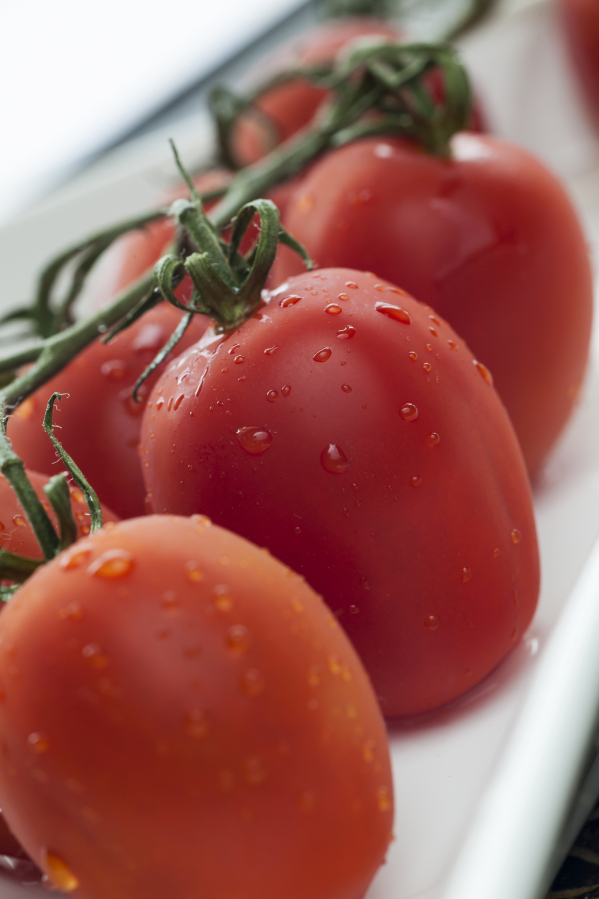Known as plum, Roma, or Italian tomatoes, these varieties are elongated counterparts to the round globe or slicing tomatoes. Prized for their lower moisture content and meatier texture, the Roma tomatoes are great in fresh or cooked, canned or stewed preparations.
Though botanically classified as a fruit, in 1893, the U.S. Supreme Court determined that tomatoes should be considered a vegetable (Nix v. Hedden).
Tomatoes are a delicious low-calorie, high-fiber treat (1 medium tomato equals 35 calories). They are a member of the nightshade family along with potatoes, eggplant, and bell peppers. Individuals with nightshade sensitivities or allergies should be aware of possible reactions to touching or consuming tomatoes.
Tomatoes develop their best flavor when vine ripened, so buying locally produced can offer a substantial taste advantage. Sugar, acid, and aroma compounds are fixed once the tomato is picked. Ripening tomatoes in a paper bag does not improve flavor.
Select tomatoes that are brightly colored, firmly textured, glossy, heavy for their size, and free of bruises, cuts, wrinkles and soft spots. Fragrance is also an indicator of ripeness. Smell the stem end and, if it smells like a tomato, it’s ripe and ready to eat.
The best way to store tomatoes is at room temperature on the counter out of direct sunlight. To increase shelf life, place the tomatoes with the stem side down to reduce the amount of oxygen entering and moisture evaporating from the tomato. Never store in the refrigerator, as the cold temperatures make the flesh pulpy and reduces flavor.
When ready to use the tomato, rinse in cool running water and gently remove any dirt or debris from the surface while being careful not to bruise or damage the tomato.
Many will consider peeling and removing the seeds from the tomatoes (especially for cooked preparations, as the skin and seeds can become bitter upon heating). However, the peel and the seeds will add more fiber to you diet.
Peeling is easily accomplished by either using a serrated knife or serrated vegetable peeler to remove the skin. The serration “grabs” the skin, making for easier removal than with a straight-bladed knife. An alternative is to score the skin on the non-stem end of the tomato, drop the tomato into boiling water for 30 to 60 seconds (until the skin curls), and then immediately place the tomato into pan of ice water. The skin should easily “slip” off. For seed removal, cut the tomato lengthwise and gently scoop or squeeze out the seeds. Using a knife, remove the stem end or core.
Plum tomatoes lend themselves to fresh preparations of snacks, salads, salsas, sauces, and stews. Keep in mind that the use of aluminum cookware and utensils should be avoided because of the high acid content of tomatoes.
For year-round enjoyment, plum tomatoes can also easily be frozen, dehydrated, pickled, and canned as sauces, ketchup, soups and paste. Plum tomatoes can also be used to make delightful salsas as well as delicious jams and marmalades.
When canning any type of tomato product always follow a recipe from a research-tested source to protect your family’s health and safety. Current tomato recipe recommendations require the addition of either citric acid or bottled lemon juice to any water bath preparation. Also, use only the amounts of vegetables specified in the research-tested canning recipe to insure a shelf-stable, safe product.
Remember, favorite recipes can always be frozen to safely preserve for future enjoyment. Specialty preparations such as tomatoes in oil or combined with garlic and onions must be frozen unless you have a safe-tested recipe.
The WSU Extension website provides free downloadable information and resources outlining safe and proven methods for canning tomatoes (PNW 300) and salsas (PNW 395) as well as other preservation topics that may be of interest.
For additional tomato recipes and serving suggestions, check out Chef Scotty’s Market Fresh Recipes at http://ext100.wsu.edu/clark/?p=8163.
Leigh Rosenberger is a Clark County WSU Extension Master Food Preserver. For additional recipes, food preservation, and food safety tips, visit http://ext100.wsu.edu/clark/?p=1134. Questions? Call MFP 360-397-6060 ext. 5366, or join Facebook Discussion Group “WSU Home Food Preservers — Clark County.”



